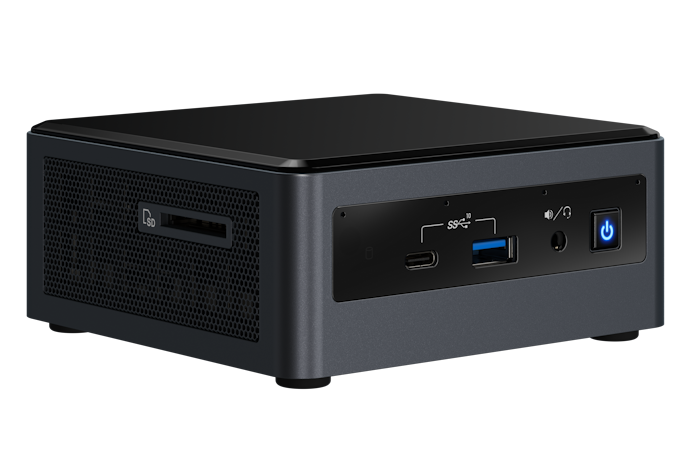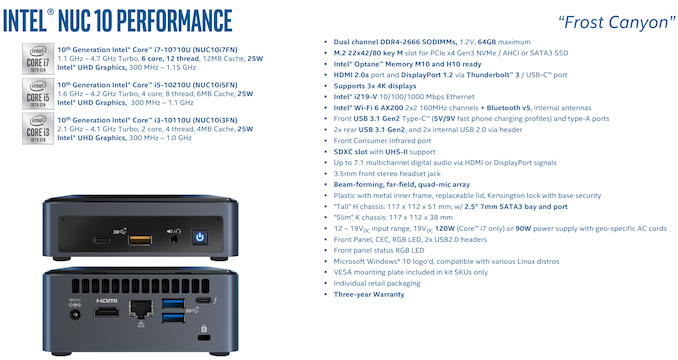Intel NUC10i7FNH Frost Canyon Review: Hexa-Core NUC Delivers a Mixed Bag
by Ganesh T S on March 2, 2020 9:00 AM ESTConcluding Remarks
The NUC10i7FNH is the latest in the line-up of mainstream NUCs from Intel. Long a niche market that Intel has dominated both directly and indirectly via its own NUCs as well as its low-TDP processors, compared where things stood a few years back, consumers these days have a number of alternatives to the mainstream NUCs. We are not referring only to the NUC clones using Intel's U-series processors, but, also the new crop of Ryzen-based UCFF PCs. The new competition means that Intel has to deliver a package that delivers more value for money compared to previous NUC offerings.
While reviewing the Bean Canyon NUC, we had indicated that it was a compact powerhouse ticking the right boxes for multiple use-cases. The tangible benefit delivered by the 'NUC8' over its predecessor was the upgrading of all the external USB ports to USB 3.2 Gen 2 (10 Gbps), and the inclusion of a more powerful Wireless-AC 9560 WLAN component. Similarly, the Frost Canyon NUC10 carries over some of the important features and also provides some welcome upgrades:
- The top-level configuration with the Core i7-10710U is a 6C/12T processor compared to the 4C/8T Core i7-8559U in Bean Canyon
- The NUC10 makes the move to Wi-Fi 6 with the AX 201 WLAN component.
- The NUC10 officially supports 64GB of DRAM (the first NUC to do so)
- One of the front panel USB 3.2 Gen 2 (10 Gbps) ports is Type-C , which is very welcome given that Type-C peripherals are becoming more prevalent now.
- The Frost Canyon NUCs make use of the latest Titan Ridge Thunderbolt 3 controller (compared to Alpine Ridge in previous NUCs), though this is transparent to the end-users of host systems. (On the peripherals side, it enables devices such as docks to talk to both Thunderbolt 3 and USB host ports).
- The BIOS has new value additions such as RAM disk creation support and pre-boot iSCSI volume mounting.
However, while the NUC8 was an upgrade over NUC7 in every respect, the Frost Canyon NUC10 slips up a little. Intel's 10th generation U-series processors come in two different versions – the 10nm Ice Lake and the 14nm Comet Lake. Intel's high-end Iris Graphics is available only on Ice Lake, and unfortunately, the Frost Canyon is based on Comet Lake. This means that, for a variety of graphics intensive workloads, the NUC10 actually performs worse than the Iris Plus graphics-equipped NUC8.
The hexa-core CPU is a nice upgrade, but, as both BAPCo SYSmark 2018 and UL's PCMark 10 show, the current typical workloads for office PCs and other generic SFF PC applications are not really capable of putting the extra cores to good use. That said, some specific tasks that scale nicely with thread counts (such as the compression and cryptography operations) can take full advantage of the capabilities offered by the Core i7-10710U in the Frost Canyon NUC10i7FNH. The availability of six cores might make the NUC an attractive option for home labs focusing on virtualization, but the requirements of the VM workloads may also need to be kept in mind given the 30W PL1 limit of the processor.
Overall, the Frost Canyon NUC10i7FNH is a mixed bag. Given a choice between, say, the Kaby Lake-based Baby Canyon NUC7 and the Coffee Lake-based Bean Canyon NUC8s, it would be a no-brainer to go for the Bean Canyon. However, choosing between Bean Canyon and Frost Canyon is not that straightforward. While Frost Canyon delivers upgrades in many respects, the retrogression in the GPU area may make the Bean Canyon NUC at a lower price point an attractive alternative. In some respects Intel has traded off GPU performance for more CPU performance, and I'm not sure that's what their NUCs really needed.
On the pricing front, the NUC10i7FNH barebones version is available for around $605, while the NUC8i7BEH is around $50 cheaper. While the two additional CPU cores and Wi-Fi 6 support can definitely justify the additional cost, it is up to the consumer to decide whether forsaking some GPU performance is also worth it.












85 Comments
View All Comments
PeachNCream - Monday, March 2, 2020 - link
Ganesh explained why the NUC was opened up in the article. Besides that, NUC systems are built to be user-accessible and are pretty simple to pull apart. It's like 4 screws to get the case open and pulling one ribbon cable off the motherboard to disconnect the mechanical drive. The barebones models are the same hardware and you have to crack the case to add storage or RAM or you do not have a complete computer.nico_mach - Tuesday, March 3, 2020 - link
I don't actually disagree with his reasoning, but I definitely have mixed feelings as a review.I forgot about the Atom NUCs completely. There's a name I haven't heard in a long time.
watzupken - Monday, March 2, 2020 - link
With the new AMD APU arriving this year, I wonder if this is dead in the water considering the higher cost of the NUC. 14nm+++ is not going to save Intel when facing off 7nm from AMD as shown in the current processor stack from both teams.timecop1818 - Monday, March 2, 2020 - link
"7nm".Intel's "14nm+++++" (keep adding pluses, retards) is closer to 10nm than AMD's crap.
Fulljack - Monday, March 2, 2020 - link
while fabrication nomenclature are now nowhere near it's actual marketed size, Intel's 14nm are still nowhere close with their own 10nm, and couldn't compete with TSMC's 7nmQasar - Monday, March 2, 2020 - link
keep posting useless, anti amd, crap. keep showing the rest of us, and demonstrate to the world that you are a nitwit, then we will let you hang yourself, king oft trollsLord of the Bored - Thursday, March 5, 2020 - link
Isn't this copy/paste'd from one of your other shill threads? Come on, man. Intel isn't paying you to repost the same old bullshit, your fans demand new content!Korguz - Thursday, March 5, 2020 - link
timecop1818 cant post new content, cause it doesnt have any.xenol - Monday, March 2, 2020 - link
The NUC product line is sort of dead in the water any way, I'd argue.YB1064 - Monday, March 2, 2020 - link
It would be helpful to include a small table that of benchmarks vs CPU performance scaling. Perhaps this is hard to do, but as a naive simple example:Benchmark#1 - scales with threads/cores
Benchmark#2 - scales with clocks/IPC
This is most likely highly complicated, but if anybody can do it, it is you guys. Ian, care to take a stab?